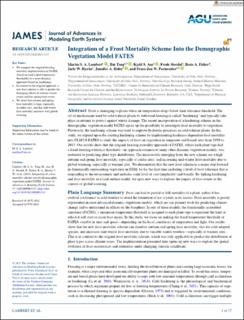Integration of a Frost Mortality Scheme Into the Demographic Vegetation Model FATES
Lambert, Marius; Tang, Hui; Aas, Kjetil Schanke; Stordal, Frode; Fisher, Rosie; Bjerke, Jarle Werner; Holm, Jennifer A.; Parmentier, Frans-Jan
Peer reviewed, Journal article
Published version

Åpne
Permanent lenke
https://hdl.handle.net/11250/3084615Utgivelsesdato
2023Metadata
Vis full innførselSamlinger
- Publikasjoner fra CRIStin - NINA [2364]
- Scientific publications [1392]
Originalversjon
10.1029/2022MS003333Sammendrag
Frost is damaging to plants when air temperature drops below their tolerance threshold. The set of mechanisms used by cold-tolerant plants to withstand freezing is called “hardening” and typically take place in autumn to protect against winter damage. The recent incorporation of a hardening scheme in the demographic vegetation model FATES opens up the possibility to investigate frost mortality to vegetation. Previously, the hardening scheme was used to improve hydraulic processes in cold-tolerant plants. In this study, we expand upon the existing hardening scheme by implementing hardiness-dependent frost mortality into CLM5.0-FATES to study the impacts of frost on vegetation in temperate and boreal sites from 1950 to 2015. Our results show that the original freezing mortality approach of FATES, where each plant type had a fixed freezing tolerance threshold—an approach common to many other dynamic vegetation models, was restricted to predicting plant type distribution. The main results emerging from the new scheme are a high autumn and spring frost mortality, especially at colder sites, and increasing mid-winter frost mortality due to global warming, especially at warmer sites. We demonstrate that the new frost scheme is a major step forward in dynamically representing vegetation in ESMs by for the first time including a level of frost tolerance that is responding to the environment and includes some level of cost (implicitly) and benefit. By linking hardening and frost mortality in a land surface model, we open new ways to explore the impact of frost events in the context of global warming.
